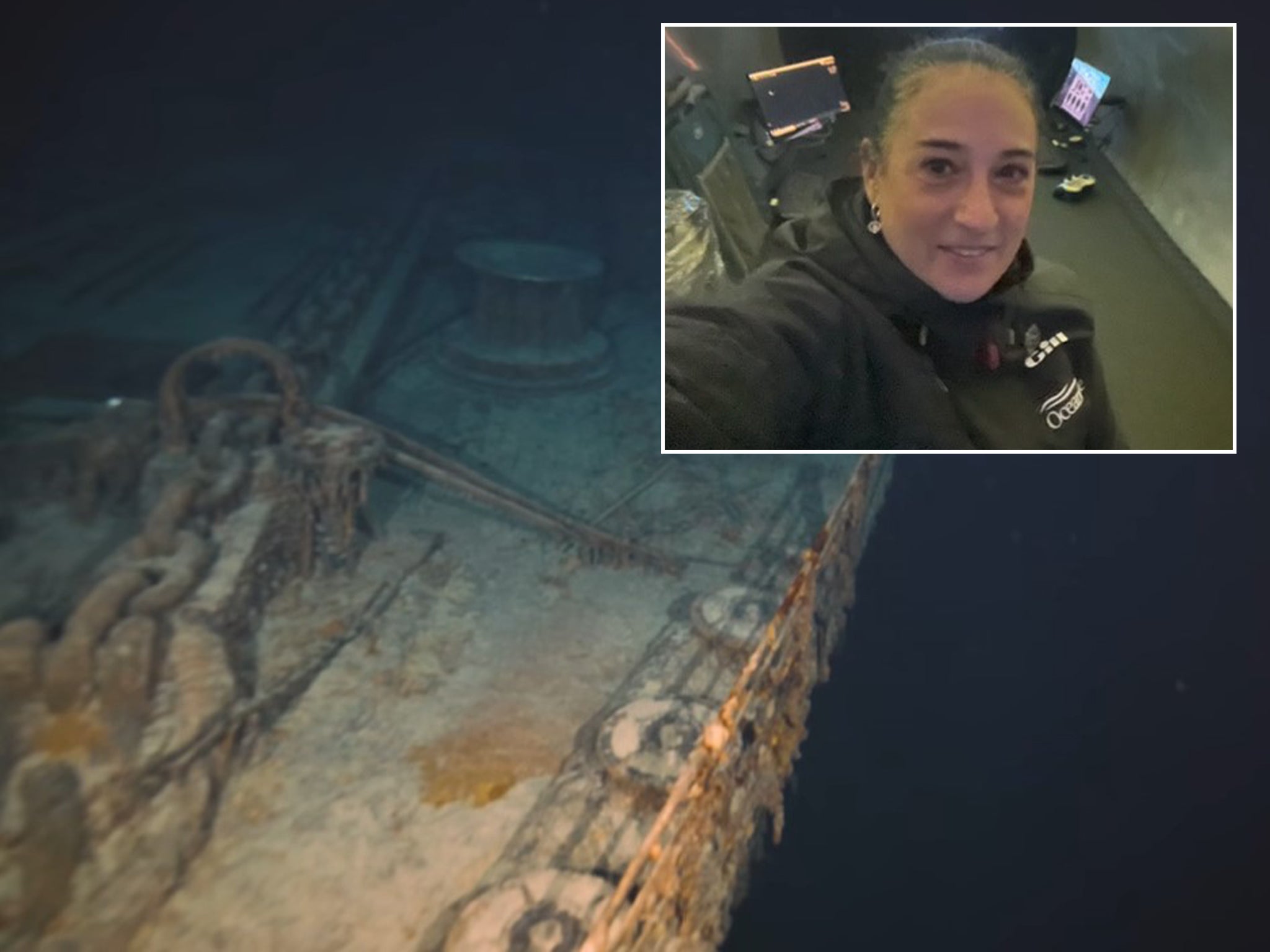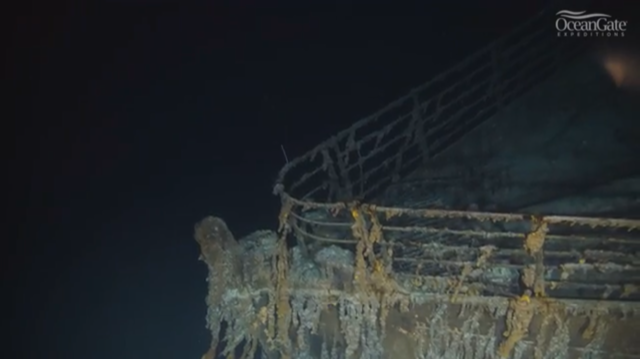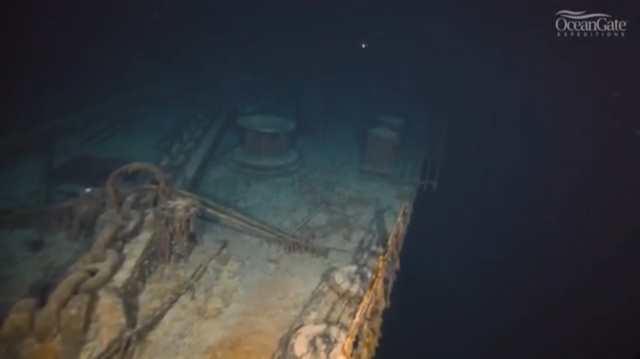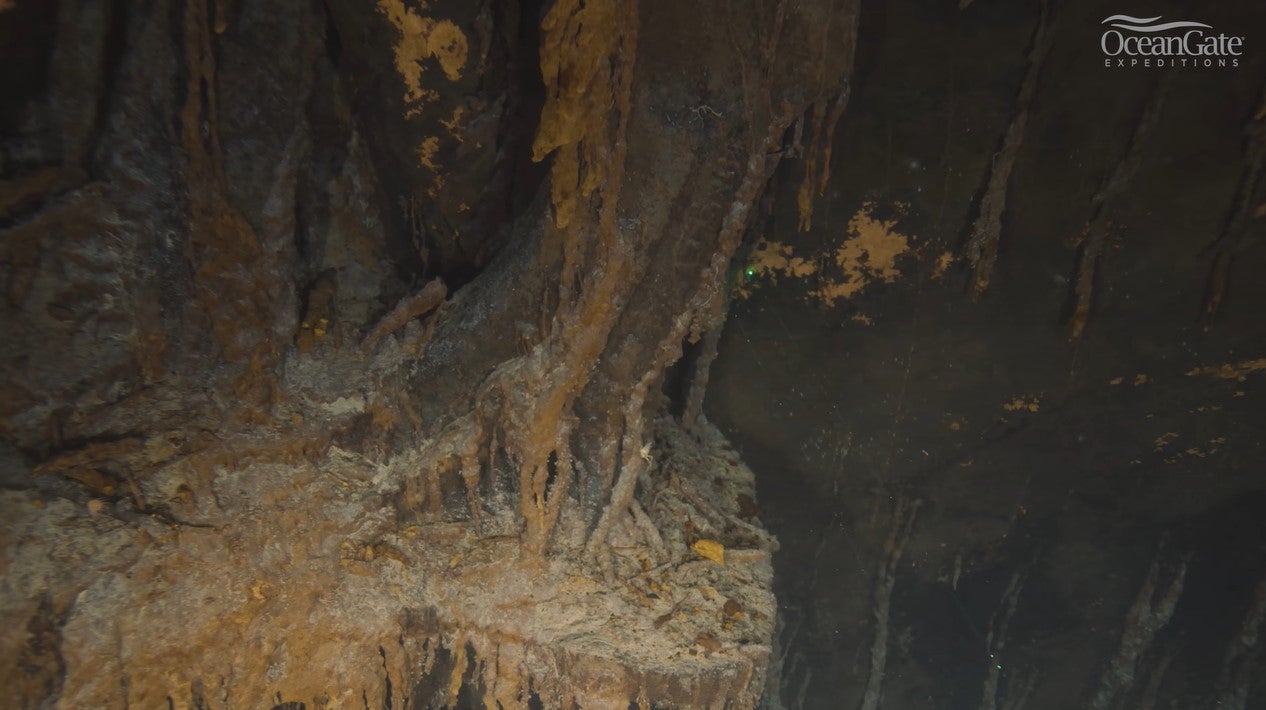Woman who visited Titanic shipwreck with OceanGate describes what it was like
One woman tells Sheila Flynn how she finally ended up visiting the famed Titanic wreck at its underwater grave after a near lifelong obsession – and what the surreal journey is actually like

Renata Rojas had been obsessed with the Titanic for more than half of her life when she looked out the window of a submersible, 4,000 metres under the North Atlantic, and saw the doomed ship’s spectre appear hauntingly from the depths.
She thought she’d cry – but she was far too busy.
Ms Rojas, 50, was one of only five people on that submersible, part of the 2022 OceanGate Titanic Expedition to the wreck in July. Accompanied by a pilot and a research scientist, she and two other “mission specialists,” civilians who could pay a six-figure price for the trip, embarked upon the meticulously-planned, deep-sea exploration.

Since the Titanic was discovered off the coast of Newfoundland in 1985 by Bob Ballard, getting to the ship has not been a cheap or easy task. Different countries and institutions have sent down expeditions. The salvage rights belong exclusively to RMS Titanic Inc, a salvage and exhibition company based in Georgia.
OceanGate Expeditions Ltd last year began the first-phase of a multi-year exploration of Titanic to explore and document “the condition of the historic shipwreck and portions of the nearly unexplored field.”
The next phase began in June, and Ms Rojas’ trip was in July. The expedition featured five missions, each over several days and several dives that could last up to ten hours each. Each of the dives included at least one scientist or content expert on each submersible to gather “archaeological and biological data” with the goal of understanding behaviour and rarity of life at such a depth while helping to predict the rate of decay of deeply submerged vessels, according to the OceanGate site.

“The deeper you go into the ocean, the less knowledgeable we are,” marine biologist Dr Steve Ross, who was on the same submersible as Ms Rojas, said before the 2022 expedition. “This study will give us an entirely different view of this one-of-a-kind habitat while also adding substantially to shared deep water DNA data sets.
He said findings such as “water samples taken and analyzed using advanced genomics technologies will not only help us identify the lifeforms we can directly observe from the Titan submersible, but will also give us a full picture of the lifeforms we cannot see.
“This includes invisible signs of both microscopic creatures and larger animals that leave traces of DNA in the water surrounding the Titanic. This research effort will contribute to conservation of the ecosystem of the wreck site.”
And reaching that site had been Ms Rojas’ goal for almost four decades.

“I wanted to find Titanic when I was 12 years old,” she tells The Independent. “I wanted to start oceanography, be an onceanographer and go find Titanic.”
If her life had gone just slightly differently – if she’d been just a bit older, or just a bit younger – it’s likely she would have spent her career investigating Titanic and its secrets.
The daughter of a diving instructor growing up in Mexico, Ms Rojas had already developed a passion for the ocean and underwater exploration when she saw an old black-and-white movie about Titanic.
“At the end of that movie, you know, Titanic hasn’t been found; it’s disappeared completely,” she says. “And I was kind of drawn to the mystery of such a large ship disappearing and nobody knowing where it was – such a tragedy that shouldn’t have happened.”
Her father’s the one who pointed out she’d need a degree in oceanography, a PhD, and as such a young student she threw herself into preparation for that career. She did papers on Titanic, she applied early to Woods Hole and was accepted, she says.
Then the Titanic was found in 1985, right before she would have started studying there. Ms Rojas says she was discouraged by the attitudes of people in the industry and those involved in the ship’s discovery; she was told that, as a woman, she shouldn’t even bother pursuing that particular passion, she tells The Independent.

“If I’d had a little bit of foresight, I would’ve said, ‘Hey, why don’t you come to Woods Hole, there’s other ships, I’m sure you can get involved in Titanic stuff,’” she says.
She’d go on to switch to banking and graduated from a university in New York, embarking on a successful career in yet another male-dominated industry.
Titanic never stopped dominating her thoughts, though. Any time there was a development regarding the ship, discoveries, history, anything, she was on top of it. She hit the speaker circuits; anyone talking about or researching Titanic, she tried to listen to, contact or connect with.
She reached out to documentary crews, scientists, everyone. When OceanGate Expeditions began letting civilians participate in trips to the wreck, she worked every contact she had. Eventually, in July – after saving for most of her life, undergoing training and spending literal decades pursuing one goal – Ms Rojas found herself hurtling towards the ocean floor in July 2022 in a submersible called Titan.
On board with her was Dr Ross; pilot Scott Griffith; and two other “mission specialists,” one who made the journey last year as well.
“We were going down fast,” Ms Rojas tells The Independent. “Everything kind of flies [by] the window. But we were doing a little of the experiments – turning the lights off and turning the lights on to see how the life outside the sub would react. As you get closer to the bottom, the pilot starts needing help. They need to deploy some of the [equipment] to slow down the descent; you don’t want to be slamming into the bottom.”
As the team scrambled to maneuver the submersible, it “really didn’t hit” Ms Rojas that they were nearing the site she’d waited so long to see and she thinks she “didn’t want to get all my hopes up, because anything can happen until you get to the bottom.”
Soon though, she began to “start realizing that you’re actually going to make it ... without any issues and you’re going to be landing at a reasonable distance from Titanic, then that’s when the feelings start going.”
She wasn’t “crying and bawling” like she expected; it was a small space, it was crowded, and there was too much to do and see.
“We approached the wreck from the back of the bow, from the aft of the bow, at the break,” she tells The Independent. “There’s a lot of debris around it. So we decided to maybe go to the front of the bow, like fast, instead of trying to go through that debris or go backwards ... so we took 10 minutes literally to drive fast alongside the wreck and then make that U-turn to have the wreck in front of us and have that legendary picture of it coming out of the bow coming out of nowhere.”
It was, she says, just like the movies, watching that mystical bow appear from the depths except there was “no Titanic music in the background.”
“We had a lot of marine snow in the cameras ... [which made] the visibility a little bit lower than usual,” she says. “But yes, once it shows up, it’s like like a wall – it’s just like the movies, just like a huge wall.”

She continues: “You’re feeling overwhelmed the entire time, not only because [of] just the fact that you were there ... [but] as we were approaching the wreck, I was wowed. That was the feeling.”
One thing that really stood out to her was when the Titan crew spotted the ship’s famed telegraph (there has been varied and legal debate over salvaging the Marconi item, which sent distress calls before Titanic eventually sank. But it’s still there.)
“Certain items are legendary,” Ms Rojas says. “Anybody will ask me, ‘What is the most important thing you found?’ The telegraph. Oh, wow. It’s copper, it’s bright - like if somebody went to shine it yesterday ... no growth on it. The lights of the sub hit it first; we were actually, at some point, turning towards the bridge.
“At some point, that roof is going to collapse and that thing’s going to go to the bottom of the ship,” Ms Rojas says, sounding still somewhat in awe that she viewed it with her own eyes.
The dive was far from just touristy sight-seeing. On the way down, they were trapping water from different levels of ocean water trenches to gauge different types of life and help for year-on year comparisons, she says. They were also tasked with collecting sediment from different sides of the shipwreck – very carefully, without disturbing anything.

“There’s all the corals around that they wanted to take pictures of – they also wanted to focus on the anchor; we wanted to see if the name was still clear,” Ms Rojas says.
The dive was practical, complicated and busy. As it neared its end, the full weight of her journey began to hit her. It overpowered her when they reached their massive ship at the surface full of crew, OceanGate staff, researchers and other mission specialists.
“I kept it together throughout the ascent,” she tells The Independent. “When we finally came back, I lost it. That’s when I finally started to sob with everybody there, you know, with the clapping and everything.”
Given that Titanic has practically been her life’s dedication, Ms Rojas’ reaction is unsurprising, but she also understands why the ship’s legacy holds such a special place in other people’s hearts.
“It’s such an iconic and legendary shipwreck ship,” she says. “I mean, it was really a ship of dreams when it was sailing ... I think it’s a combination of the mystery, the time, the change it created in the world.
“I don’t want to compare it to September 11, but it was September 11” of its time, she tells The Independent.
“It’s like you feel like you have to go pay your respects... It wasn’t supposed to happen,” she explained. “Even if you see it on TV, BBC and documentaries, you kind of know the pull is such that ... you have to be there and see it in person. It’s a combination of the tragedy of so many people dying, of the richness, of the fact that it was unsinkable.”



Join our commenting forum
Join thought-provoking conversations, follow other Independent readers and see their replies
Comments